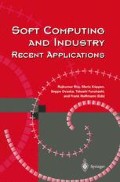Abstract
We have previously shown [Langdon and Buxton, 2001b] on a range of benchmarks genetic programming (GP) can automatically fuse given classifiers of diverse types to produce a combined classifier whose Receiver Operating Characteristics (ROC) are better than [Scott et al., 1998]’s “Maximum Realisable Receiver Operating Characteristics” (MRROC). i.e. better than their convex hull. Here our technique is used in a blind trial where artificial neural networks are trained by Clementine on P450 pharmaceutical data. Using just the networks, GP automatically evolves a composite classifier.
Access this chapter
Tax calculation will be finalised at checkout
Purchases are for personal use only
Preview
Unable to display preview. Download preview PDF.
References
Peter J. Angeline. Multiple interacting programs: A representation for evolving complex behaviors. Cybernetics and Systems, 29(8):779–806, November 1998.
Robert A. Jacobs, Michael I. Jordon, Steven J. Nowlan, and Geoffrey E. Hinton. Adaptive mixtures of local experts. Neural Computation, 3:79–87, 1991.
John R. Koza. Genetic Programming: On the Programming of Computers by Means of Natural Selection. MIT Press, 1992.
W. B. Langdon and B. F. Buxton. Evolving receiver operating characteristics for data fusion. In Julian F. Miller, Marco Tomassini, Pier Luca Lanzi, Conor Ryan, Andrea G. B. Tettamanzi, and W. B. Langdon, editors, Genetic Programming, Proceedings of EuroGP’2001, volume 2038 of LNCS, pages 87–96, Lake Como, Italy, 18–20 April 2001. Springer-Verlag.
W. B. Langdon and B. F. Buxton. Genetic programming for combining classifiers. In Lee Spector, Erik D. Goodman, Annie Wu, W. B. Langdon, Hans-Michael Voigt, Mitsuo Gen, Sandip Sen, Marco Dorigo, Shahram Pezeshk, Max H. Garzon, and Edmund Burke, editors, Proceedings of the Genetic and Evolutionary Computation Conference (GECCO-2001), pages 66–73, San Francisco, California, USA, 7–11 July 2001. Morgan Kaufmann
W. B. Langdon and B. F. Buxton. Genetic programming for improved receiver operating characteristics. In Josef Kittler and Fabio Roli, editors, Second International Conference on Multiple Classifier System, volume 2096 of LNCS, pages 68–77, Cambridge, 2-4 July 2001. Springer Verlag.
W. B. Langdon and Riccardo Poli. Foundations of Genetic Programming. Springer, 2001.
W. B. Langdon, Terry Soule, Riccatdo Poli, and James A. Foster. The evolution of size and shape. In Lee Spector, W. B. Langdon, UnaMay O’Reilly, and Peter J. Angeline, editors, Advances in Genetic Programming 3, chapter 8, pages 163–190. MIT Press, 1999.
W. B. Langdon. Data Structures and Genetic Programming. Kluwer, 1998.
W. B. Langdon. Size fair and homologous tree genetic programming crossovers. Genetic Programming and Evolvable Machines, 1(1/2):95–119, April 2000.
Sean Luke and Liviu Panait. A survey and comparison of tree generation algorithms. In Lee Spector, Erik D. Goodman, Annie Wu, W. B. Langdon, Hans-Michael Voigt, Mitsuo Gen, Sandip Sen, Marco Dorigo, Shahram Pezeshk, Max H. Garzon, and Edmund Burke, editors, Proceedings of the Genetic and Evolutionary Computation Conference (GECCO-2001), pages 81–88, San Francisco, California, USA, 7-11 July 2001. Morgan Kaufmann.
[Scott et al., 1998]-M. J. J. Scott, M. Niranjan, and R. W. Prager. Realisable classifiers: Improving operating performance on variable cost problems. In Paul H. Lewis and Mark S. Nixon, editors, Proceedings of the Ninth British Machine Vision Conference, volume 1, pages 304–315, University of Southampton, UK, 14-17 September 1998.
Terence Soule. Voting teams: A cooperative approach to non-typical problems using genetic programming. In Wolfgang Banzhaf, Jason Daida, Agoston E. Eiben, Max H. Garzon, Vasant Honavar, Mark Jakiela, and Robert E. Smith, editors, Proceedings of the Genetic and Evolutionary Computation Conference, volume 1, pages 916–922, Orlando, Florida, USA, 13-17 July 1999. Morgan Kaufmann.
Y. Yusoff, J. Kittler, and W. Christmas. Y. Yusoff, J. Kittler, and W. Christmas. Combining multiple experts for classifying shot changes in video sequences. In IEEE International Conference on Multimedia Computing and Systems, volume II, pages 700–704, Florence, Italy, 7-11 June 1998.
Author information
Authors and Affiliations
Editor information
Editors and Affiliations
Rights and permissions
Copyright information
© 2002 Springer-Verlag London
About this chapter
Cite this chapter
Langdon, W.B., Barrett, S.J., Buxton, B.F. (2002). Genetic Programming for Combining Neural Networks for Drug Discovery. In: Roy, R., Köppen, M., Ovaska, S., Furuhashi, T., Hoffmann, F. (eds) Soft Computing and Industry. Springer, London. https://doi.org/10.1007/978-1-4471-0123-9_51
Download citation
DOI: https://doi.org/10.1007/978-1-4471-0123-9_51
Publisher Name: Springer, London
Print ISBN: 978-1-4471-1101-6
Online ISBN: 978-1-4471-0123-9
eBook Packages: Springer Book Archive

